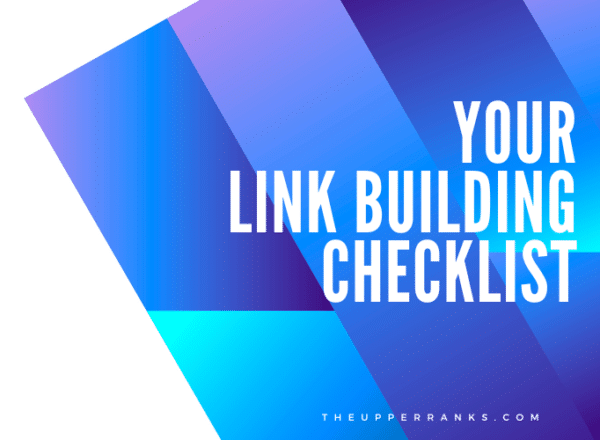I don’t know about you, but I like checklists.
They’re the most effective way to keep track of your processes and activities. Sometimes these checklists can be pretty granular, like a grocery shopping list. Perhaps you’re organizing a function, like a conference.
You have a spreadsheet that contains everything that needs to be done over the course of six months. Even though the checks you mark may come at a more gradual speed, it’s still a checklist.
It’s even good to have a checklist for processes you know pretty well by heart and/or muscle memory. We’re all human.
That’s why I have a checklist I like to use for link building campaigns. Even though I’ve worked on more campaigns than I can even count at this point, it’s better to be safe than sorry.

And no, a checklist doesn’t have to make you stringent. It’s good to allow yourself freedom and customization for certain campaigns; you never know what a new client might demand or what restrictions their respective niche might face. But you should have a checklist of some kind, and I’m happy to help provide you with one.
Here is the checklist for starting a new link building project.
Current Backlink Profile Analysis
While no one knows anything about Google’s algorithm with certainty, case studies have proven time and time again that Google likes it when you have more links from unique domains. That’s one reason you should conduct a backlink analysis as one of the first things you do.
There are a multitude of things that this analysis can help you to accomplish. First off, you can get an idea of the links from sites that you already have, and therefore don’t need to bother reaching out to (at least not in the short-term). Plus you can also use this as an opportunity to thank them for the link and start developing that ‘relationship building’ everyone loves to talk about.
You also have a chance to find the bad links.

And by “bad links,” I mean links that could be adversely affecting your rankings. You might have a few mediocre links out there: I’m not talking about links on sites that receive very little traffic or minimal authority. These links aren’t doing you much good, but they’re relatively harmless (unless you’re using exact match anchor text across all of them).
A “bad link” is a link on a site that is not at all relevant to you and has no business linking to you. It may not even be in your native language. It’s possible your competitor built this link in your name to hurt you; it happens. Find these links and add them to a disavow list, as these links can cause damage.
Competitor Analysis
Just like a football team spends the preceding week watching game tape of their upcoming opponent, it’s imperative to analyze the types of links your competitors have.
There are multiple benefits to a competitor analysis. First off, you may find potential target site opportunities missing from your current backlink profile. It’s a good idea to chase the more valuable opportunities you find here (valuable in terms of domain authority, traffic, etc.). Getting links from the sites your competitors have links on will neutralize their advantage.
This kind of competitor analysis is also good simply for getting a fuller understanding of your niche. What kind of content performs well? What types of sites are more willing to link?
The more you understand what you’re getting into, the more high-quality links you will build.
Fresh Mentions
Is your ear itching? If you’re superstitious, that means someone is talking about you.

There’s a digital way of figuring this out without having to scratch your ear: set up Google Alerts.
A “mention” is not dissimilar to what it sounds like: it’s when someone else is talking about you/your brand. Many mentions go unlinked, however.
When you set up Google Alerts (or similar mention finders) you will get notifications when your name and/or focus keywords are published. That’s when you can outreach the sites that published them to see if you can persuade them to simply put the <a href> tag in the code.
Build Your Outreach
This seems like a no-brainer; how are you going to build links if you don’t do any outreach? There’s a little bit more that goes into this than setting up an email address.
Create social media accounts. Write up some email templates (but don’t live and die by these templates, as personalized outreach is always preferable). Start following the profiles of targets sites and influencers. It’s usually a mistake to reach out immediately to bigger value sites; it’s better to wait and observe. Speaking of which…
Find Relevant Websites
Link building is relationship building. It’s a maxim you’ve probably heard at SEO conferences, but that’s because it’s true.
When you build links, you don’t really just want any link. Sure, a handful of mediocre links is better than nothing, but that handful won’t move the needle the same way even one super-relevant link can.
This is why you should try and find relevant websites within your niche. These may be websites that are run by individuals, relevant associations/organizations, or webmasters that manage relevant resource pages: either way, building relationships with these relevant websites will prove advantageous in the end. It may take a while for the benefits to come to fruition, but welcome to the world of SEO.
Setting Goals
If this is the part of the article where you think I’m going to tell you how many links you need to be building per month, sorry. Link building doesn’t work that way.

The effectiveness of a link building campaign is going to vary from link builder to link builder and from project to project. Some measure by the quality of the links they’re getting; others by the quantity.
No matter how you want to determine your goals, it’s a good idea to have some from the outset. There’s nothing more destructive than an aimless project in any business setting. You can think of goals in terms of the gets (the links), or you can think of them in terms of production (how many emails to send in one day). Either way, having set goals will help you tremendously, even when you fail to meet them.
Content Audit
One of the most famous quotes in regards to the internet is, “Content is king.” This was said by Bill Gates in 1996.
A lot has changed about the internet since 1996. There was no social media, for one thing. If you wanted to talk to a friend across the country, you had to call them.
Gates’ 1996 phrase still rings true today, and while it’s possible to build link without content, you’re making it harder on yourself. That’s why every link building campaign should not be commenced without an audit of your site to what current linkable assets you have. If you don’t have any? Time to brainstorm and execute. One of the biggest hurdles of link building is providing webmasters a reason to link to you. When you have one or more linkable assets with clear value, it makes your job much easier.
Build a List of Target Sites
Rather than finding one site at a time and reaching out, it’s better to build a pool of potential target sites before you start any outreach. This is commonly referred to as link prospecting.

The amount of targets sites you have in the bank will vary from project to project. Anyone who’s worked on link building campaigns for multiple niches knows that some niches aren’t rich with target sites the same way others are. Regardless, it’s better to have a set amount of sites ready to go before you write a word of outreach.
Conclusion
Even when you’ve been link building for years, it never hurts to be organized so that you hall of your ducks in a row.
There’s obviously more to link building than everything I just laid out, but with this checklist, you will never miss out on the fundamentals again.

Comments
Nice blog. This is exactly what I was looking for. Thank you so much for sharing.